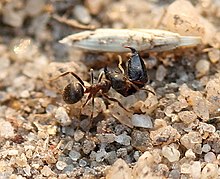This article needs additional citations for verification. (August 2011) |
| Black garden ant | |
|---|---|

| |
| Black garden ants tending to mealybugs | |
| Scientific classification | |
| Domain: | Eukaryota |
| Kingdom: | Animalia |
| Phylum: | Arthropoda |
| Class: | Insecta |
| Order: | Hymenoptera |
| Family: | Formicidae |
| Subfamily: | Formicinae |
| Genus: | Lasius |
| Species: | L. niger
|
| Binomial name | |
| Lasius niger | |

The black garden ant (Lasius niger), also known as the common black ant, is a formicine ant, the type species of the subgenus Lasius, which is found across Europe and in some parts of North America, South America, Asia and Australasia. The European species was split into two species; L. niger, which are found in open areas; and L. platythorax, which is found in forest habitats.[1] It is monogynous, meaning colonies contain a single queen.
Lasius niger colonies normally range from 4,000 to 7,000 workers, but can reach 40,000 in rare cases. A Lasius niger queen can live for up to 29 years[2] the longest recorded lifespan for any eusocial insect.[3] Lasius niger queens in the early stages of founding can have two to three other queens in the nest. They will tolerate each other until the first workers come, then it is most likely they will fight until one queen remains. Under laboratory conditions, workers can live at least 4 years.[4]
Lasius niger is host to a number of temporary social parasites of the Lasius mixtus group including Lasius mixtus and Lasius umbratus.
- ^ Klotz, John H. (2008). Urban Ants of North America and Europe: Identification, Biology, and Management. Cornell University Press. pp. 39–44. ISBN 978-0801474736.
- ^ Lucas ER, Privman E, Keller L (2016). "Higher expression of somatic repair genes in long-lived ant queens than workers". Aging. 8 (9): 1940–1951. doi:10.18632/aging.101027. PMC 5076446. PMID 27617474.
- ^ Kramer, Boris H.; Schaible, Ralf; Scheuerlein, Alexander (December 2016). "Worker lifespan is an adaptive trait during colony establishment in the long-lived ant Lasius niger". Experimental Gerontology. 85: 18–23. doi:10.1016/j.exger.2016.09.008. PMID 27620822.
- ^ Czaczkes, T. J. (2017). "unpublished data".
{{cite journal}}: Cite journal requires|journal=(help)